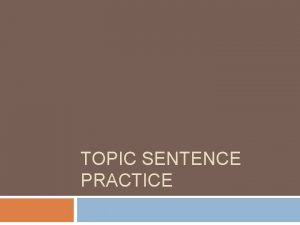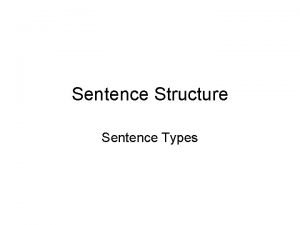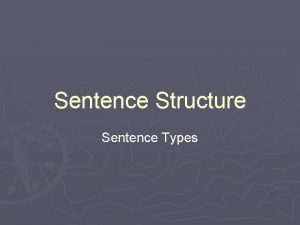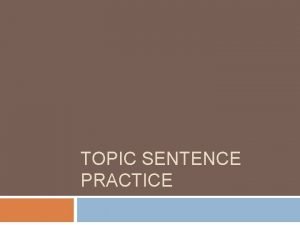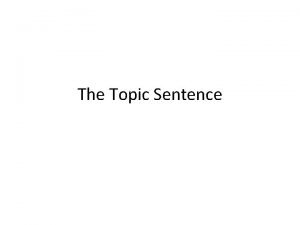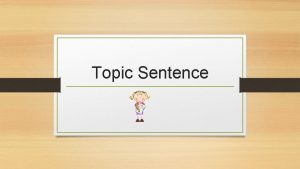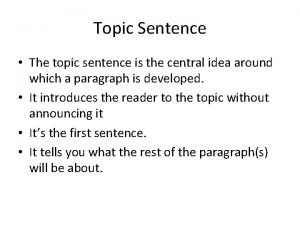TTopic Sentence Topic sentence the first sentence of




















- Slides: 20


T=Topic Sentence Topic sentence (the first sentence of your paragraph): Must be insightful Must be defendable and arguable (no statements like “Harry Potter is a wizard. ”) Ideally not a plot event Ideally include a function word Ideally include the author’s name (to keep focus on the HOW) Most important: the best topic sentences are analytic in nature, not descriptive.

Ineffective openings to paragraphs… Throughout the entire story, the narrator focuses on the yellow wallpaper in the room she stays in. The unnamed female character is being treated by her physician husband John. The woman in this story is put in an old nursery by her husband John. Although the yellow wallpaper is the main surrounding in this piece, many other places play a large role as well. (Not as ineffective as the others, but it’s quite vague. )

This is how you start a body paragraph! The opening paragraphs of the “Yellow Wallpaper” quickly establish the narrator’s feelings toward the house. The psychological condition of the narrator transforms in a rather quick and sharp manner. This abstract, “unclean yellow” wallpaper that is used to disgust and humiliate her now creates a whole new set of feelings and emotions inside her. As the conclusion of the story approaches, there is a dramatic shift in the author’s attitude. Gilman also makes the main setting focal point—the yellow wallpaper—stand out more by ironically placing it next to far more concerning setting elements.

I=Integrate/introduce quote Never “plunk” down a quote! You may use a colon to introduce a quote, but don’t overuse it: She interacts with the wallpaper daily with great detail: “looked at it in one way each breadth stands alone, the bloated curves and finishes. ” Or, include some key phrases in your own sentence (this works well with adjectives): She interacts with the “bloated curves and finishes” of the wallpaper almost daily. …She describes the grounds of the “colonial mansion” and “untenanted” estate and also many of the rooms inside, noting the “

Q=Quote (or support) Ideally, you want to QUOTE whenever possible. However, you will not have the text in front of you in the exam!. What do you do? Memorize key quotes before hand (I am not kidding!) Utilize specific details from the story instead (not generalizations) Get as close as possible to the real quote (readers don’t mind) Why use your own adjectives/imagery when you can use the author’s? “lurid yellow” “scratched and gouged and splintered” “sprawling” “optic horror” “wallowing seaweeds”

A=Analysis This is the most important part! “Insight sandwich” Insightful opening (topic sentence) Support and reasoning Insightful closing (analysis) Don’t end paragraph with a quote. This is where you can tie to the “meaning of the work as a whole” to make sure you answer that!

…. In lines 43 -45 on the last page, Gilman writes, “for outside you have to creep on the ground, and everything is green instead of yellow. ” This proves that even though she could have left the room, she didn’t because she is not “consumed” by the wallpaper and her solitude. In lines 43 -45 on the last page, Gilman writes, “for outside you have to creep on the ground, and everything is green instead of yellow. ” This proves that the outside is more pleasant than the inside. (STILL doesn’t address HOW this works!) ***** In lines 43 -45 on the last page, Gilman writes, “for outside you have to creep on the ground, and everything is green instead of yellow. ” The presentation of colors and the use of the word “instead” highlights the difference between the outside and the inside…. (keep going with why this matters…. )

Analysis connecting to MOTWAW …. By illuminating the realization that she depicted herself as part of the yellow wallpaper, one realizes just how badly it truly was for health—she no longer was Jennie, but the woman in the yellow wallpaper. This illustrates the author’s view that mental health is not beling cared for the correct way, reflecting the movement at the turn of the century to create hospitals for mental diseases. (not historically accurate, but a clear attempt to address the larger implications/big idea) The “Big Idea” should be addressed clearly in the intro and again in the conclusion. But don’t forget it throughout.

…. Furthermore, the physical makeup of the house itself contributes to the character’s downfall. For example, the floor in her room “is scratched and gouged and splintered” and the wallpaper has a “dull” color that “confuses” and “irritates” the eyes. Her settings in the house emphasize the way she feels inside: colorless like the wallpaper, mistreated like the floor, and confused angry at the way her husband dismisses her mental issues. All of these combined eventually cause her insanity.

Body paragraph In the beginning of the story, the idea of using surroundings to affect the mind has a positive intention. The narrator’s husband, John, is a physician and hoped to cure the narrator by making her rest in a pleasant, airy, and pristine colonial mansion in the countryside. His attempt to cure the illness with the surroundings is ironic in the fact that later in the story it ends up making the narrator more ill. It ironically foreshadows the extreme affect [sic] the surroundings eventually have. Even though the surroundings end up having and adverse affect [sic] on the narrator, it still shows the extreme results that a person’s surroundings can have on his or her mental state.

The speaker’s becoming into insanity is foreshadowed by her take on the new estate. At the beginning of the story, the speaker describes the grounds as “queer” and “empty. ” She even speculates about it being haunted: “why should it be let so cheaply? And why have stood so long untenanted? ” Her analysis of the house forbode a darkness and her eventual insanity but also her curiosity with it. This curiosity indicates that she will approach her insanity and delve further into it. This is depicted through her eventual obsession with the wallpaper and its envelopment of her thoughts. She interacts with the wallpaper daily with great detail: looked at in one way each breadth stands alone, the bloated curves and flourishes. ” Her curiosity with the wallpaper and lack of distraction is ultimately her pitfall into insanity. She is literally surrounded by this tempter and its inescapable nature rots her mind.

Thesis sentences that worked… Society’s dismissive attitude toward women, the narrator’s lack of freedom, and the immediate physical surroundings all pose detrimental effects on her psychological stability, revealing society’s ignorant perception of those mentally unstable and vulnerability of the human mind. Gilman exposes the true treatment and reality of women in the 19 th century through a combination of physical and cultural surroundings. The yellow wallpaper comes to life, the stagance (stagnation) of the setting driving her slowly insane and highlighting the effect of solitude and being too stuck in your own head. Gilman uses influences from her own life of the 19 th century and the mentally destructive wallpaper to demonstrate the inadequate treatment of women prior to the 20 th century. Through her constant description of the environment and her evolving relationship with her husband, Gilman illustrates the deterioration of one woman’s mental state and the horrors that follow. Gilman hopes that such horrific descriptions will bring about change with regards to mental health treatment.

Interesting ideas…. What many people don’t realize is that the wallpaper was saving her.

An upside down paragraph… The woman in this story is put in an old nursery by her husband John. She complains about the wallpaper to John. She describes it as a repellent yellow. The hatred she has for the wallpaper supports her mindset on not wanting to be in that room. All she wanted to do was leave that room. The wallpaper delivers the different stages of her mindset going from sane to crazy.

The woman in this story is put in an old nursery by her husband John. She complains about the wallpaper to John. She describes it as a repellent yellow. The hatred she has for the wallpaper supports her mindset on not wanting to be in that room. All she wanted to do was leave that room. The wallpaper delivers the different stages of her mindset going from sane to crazy.

The woman in this story is put in an old nursery by her husband John. She complains about the wallpaper to John. She describes it as a repellent yellow. The hatred she has for the wallpaper supports her mindset on not wanting to be in that room. All she wanted to do was leave that room. The wallpaper delivers the different stages of her mindset going from sane to crazy.

The wallpaper delivers is the catalyst for the different stages of her mindset going from sane to crazy. In the beginning of the story, she describes the room as “airy” and bright, though a bit queer. She does not want to remain in the room, and she begs John to allow her to sleep elsewhere. However, at the end of the story, she becomes possessive of the paper and the room and locks herself in, even throwing the key out of the window. The room’s consumption of her spirit and mind is complete as she becomes one with the space—even using the third person to refer to herself as the woman in the wall. With this, it is evident that the environment has transformed her and rendered the “rest cure” a failure—a testament to the ignorance of the current medical community.

“The wallpaper delivers reflects the different stages of her mindset going from sane to crazy. ” Starting here gives the writer something to work with. It is an arguable point that requires evidence to prove. It is interesting.

 Ttopic
Ttopic Main idea and irrelevant idea
Main idea and irrelevant idea Paragraph writing strategies
Paragraph writing strategies What are the steps in narrowing down research topic
What are the steps in narrowing down research topic Kinds of concluding sentences
Kinds of concluding sentences Hát kết hợp bộ gõ cơ thể
Hát kết hợp bộ gõ cơ thể Lp html
Lp html Bổ thể
Bổ thể Tỉ lệ cơ thể trẻ em
Tỉ lệ cơ thể trẻ em Chó sói
Chó sói Glasgow thang điểm
Glasgow thang điểm Chúa yêu trần thế
Chúa yêu trần thế Môn thể thao bắt đầu bằng từ đua
Môn thể thao bắt đầu bằng từ đua Thế nào là hệ số cao nhất
Thế nào là hệ số cao nhất Các châu lục và đại dương trên thế giới
Các châu lục và đại dương trên thế giới Công thức tính độ biến thiên đông lượng
Công thức tính độ biến thiên đông lượng Trời xanh đây là của chúng ta thể thơ
Trời xanh đây là của chúng ta thể thơ Cách giải mật thư tọa độ
Cách giải mật thư tọa độ Phép trừ bù
Phép trừ bù Phản ứng thế ankan
Phản ứng thế ankan Các châu lục và đại dương trên thế giới
Các châu lục và đại dương trên thế giới





















